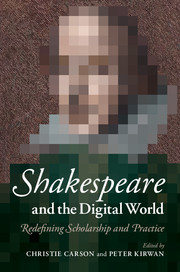Book contents
- Frontmatter
- Contents
- Notes on contributors
- Acknowledgements
- Shakespeare and the digital world
- Part I Defining current digital scholarship and practice
- 1 Shakespeare in the digital humanities
- 2 Getting back to the library, getting back to the body
- 3 Sensing the past
- 4 Webs of engagement
- Part II Defining current digital scholarship and practice
- Half-time: A pause for reflection
- Part III Redefining the boundaries and practices of Shakespeare studies online
- Part IV Redefining the boundaries and practices of Shakespeare studies online
- Index
- References
2 - Getting back to the library, getting back to the body
Published online by Cambridge University Press: 05 July 2014
- Frontmatter
- Contents
- Notes on contributors
- Acknowledgements
- Shakespeare and the digital world
- Part I Defining current digital scholarship and practice
- 1 Shakespeare in the digital humanities
- 2 Getting back to the library, getting back to the body
- 3 Sensing the past
- 4 Webs of engagement
- Part II Defining current digital scholarship and practice
- Half-time: A pause for reflection
- Part III Redefining the boundaries and practices of Shakespeare studies online
- Part IV Redefining the boundaries and practices of Shakespeare studies online
- Index
- References
Summary
It was a shock. My reader’s card at the Huntington Library had expired, and there I was at the reception desk, in a hurry to see a certain text and in no mood to go through the ordeal in which I was already involved. The moment caught me up short, in more ways than one. There was a time when access to the sixteenth-century book that I wanted to see would have involved a long journey to a research library. Centuries earlier it might have required a letter of introduction to a noble person or a learned society or an amenable book-collector. In either case, I would have had plenty of time to consider the temporal distance – the multiple measures of temporal distance – between myself and the sixteenth-century book. My impatience at the Huntington reception desk, I realized, was presentism, with a vengeance.
The text in question was Julius Caesar Scaliger’s Poetics (1561 and later editions), a Latin text that supplied George Puttenham, Philip Sidney, Ben Jonson, and most other sixteenth-century poets and rhetoricians with the cue to think about poetic feet as physical feet, as bodily movements in space and time. ‘Finding Your Footing in Shakespeare’s Verse’ was the title of a paper I was working on for a conference at UCLA called ‘Where has all the Verse Gone?,’ a paper ultimately destined for Oxford University Press’s Handbook of Shakespeare’s Poetry (Post, 2013). All the other early modern texts I needed for this enterprise – Puttenham’s The Art of English Poesie, Sidney’s An Apology for Poetry, Jonson’s Timber, or Discoveries – were available to me right at my desk at home, just four clicks of the mouse and one password away, through Early English Books Online. In fact, by accessing digital images of the pages of these books through EEBO’s Text Creation Partnership, I didn’t even have to rely on my recollections of just where the passages I wanted were located: I could simply enter a keyword as a search term, and there the desired text would be on my computer screen, ready for cutting and pasting directly into my draft.
- Type
- Chapter
- Information
- Shakespeare and the Digital WorldRedefining Scholarship and Practice, pp. 24 - 32Publisher: Cambridge University PressPrint publication year: 2014
References
- 1
- Cited by



